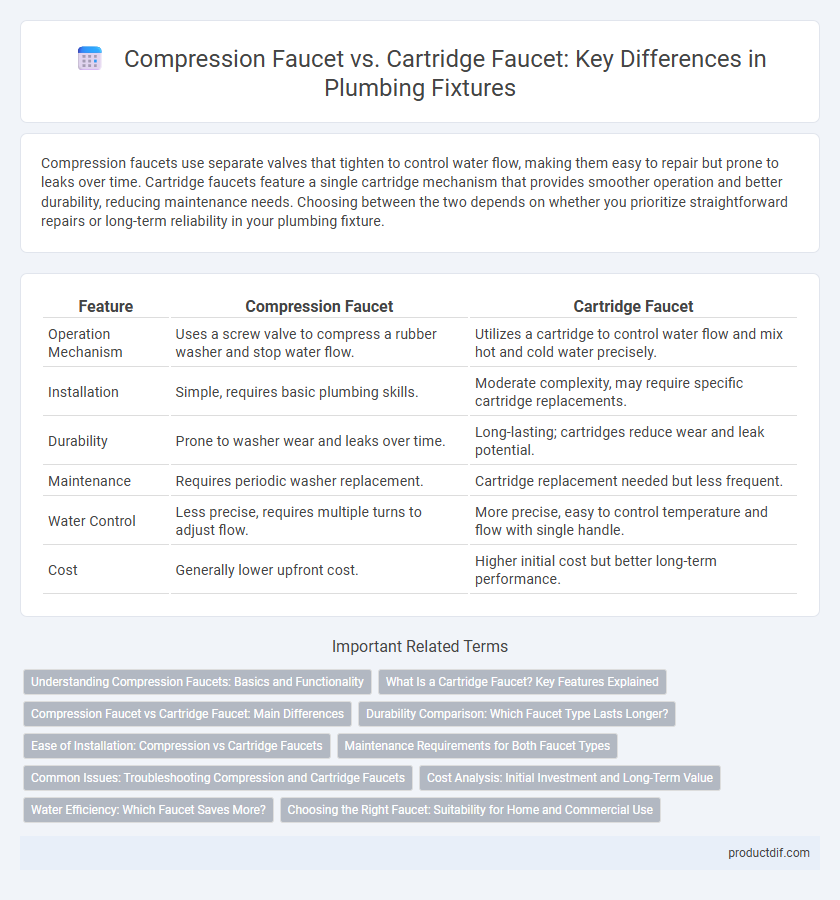Compression faucets use separate valves that tighten to control water flow, making them easy to repair but prone to leaks over time. Cartridge faucets feature a single cartridge mechanism that provides smoother operation and better durability, reducing maintenance needs. Choosing between the two depends on whether you prioritize straightforward repairs or long-term reliability in your plumbing fixture.
Table of Comparison
| Feature | Compression Faucet | Cartridge Faucet |
|---|---|---|
| Operation Mechanism | Uses a screw valve to compress a rubber washer and stop water flow. | Utilizes a cartridge to control water flow and mix hot and cold water precisely. |
| Installation | Simple, requires basic plumbing skills. | Moderate complexity, may require specific cartridge replacements. |
| Durability | Prone to washer wear and leaks over time. | Long-lasting; cartridges reduce wear and leak potential. |
| Maintenance | Requires periodic washer replacement. | Cartridge replacement needed but less frequent. |
| Water Control | Less precise, requires multiple turns to adjust flow. | More precise, easy to control temperature and flow with single handle. |
| Cost | Generally lower upfront cost. | Higher initial cost but better long-term performance. |
Understanding Compression Faucets: Basics and Functionality
Compression faucets operate using a simple mechanism involving rubber washers that press down onto a valve seat to control water flow. When the handle is turned, the washer compresses against the valve seat, stopping water from passing through, making them durable and easy to repair. These faucets are commonly found in older plumbing systems and provide reliable control over hot and cold water separately.
What Is a Cartridge Faucet? Key Features Explained
A cartridge faucet uses a movable stem cartridge within its valve body to control water flow and temperature precisely, offering smooth and reliable operation. Key features include easy maintenance due to replaceable cartridges, durability against leaks, and consistent control of hot and cold water blending. Unlike compression faucets that rely on washers, cartridge faucets provide more efficient water control and longer-lasting performance in plumbing fixtures.
Compression Faucet vs Cartridge Faucet: Main Differences
Compression faucets use separate handles to control hot and cold water flow by tightening a washer that compresses against a valve seat, often resulting in leaks over time due to washer wear. Cartridge faucets feature a movable cartridge inside the faucet body that controls both temperature and flow with a single handle, offering smoother operation and easier maintenance. Compression faucets are generally more affordable but less durable, while cartridge faucets provide improved reliability and user convenience.
Durability Comparison: Which Faucet Type Lasts Longer?
Compression faucets feature rubber washers that wear out faster, leading to frequent maintenance and shorter lifespan. Cartridge faucets utilize a solid valve cartridge made from metal or ceramic, ensuring superior durability and resistance to leaks. On average, cartridge faucets can last 10-20 years, whereas compression faucets typically require replacement or repair within 5-10 years.
Ease of Installation: Compression vs Cartridge Faucets
Compression faucets require separate hot and cold water controls with traditional screw-on handles, making installation more labor-intensive and prone to leaks without proper sealing. Cartridge faucets feature a single handle or dual lever that simplifies alignment and reduces installation time due to pre-assembled internal components. The streamlined design of cartridge faucets often results in fewer parts to handle, enhancing overall ease of installation compared to compression faucets.
Maintenance Requirements for Both Faucet Types
Compression faucets require regular tightening of the packing nut and replacement of rubber washers due to frequent wear from valve stem movement, leading to more intensive maintenance. Cartridge faucets feature fewer moving parts and use a cartridge mechanism that minimizes leaks and simplifies repair, resulting in lower maintenance demands over time. Proper maintenance of either type involves timely identification of leaks and corrosion to extend faucet lifespan and ensure optimal water flow.
Common Issues: Troubleshooting Compression and Cartridge Faucets
Compression faucets often experience leaks due to worn-out rubber washers or corroded valve seats, which require replacing these parts to restore function. Cartridge faucets commonly face problems like dripping or difficulty in handle movement, typically caused by cartridge damage or mineral buildup, necessitating cartridge replacement or thorough cleaning. Addressing these issues promptly with the correct repair components ensures efficient water flow and prevents further plumbing damage.
Cost Analysis: Initial Investment and Long-Term Value
Compression faucets typically have a lower initial investment due to their simpler design and widespread availability of parts, making them a budget-friendly choice for basic plumbing needs. Cartridge faucets, while often more expensive upfront, offer enhanced durability and easier maintenance, leading to lower long-term repair costs and improved water efficiency. Evaluating total cost of ownership reveals cartridge faucets provide greater value over time through fewer leaks and reduced replacement frequency.
Water Efficiency: Which Faucet Saves More?
Cartridge faucets offer superior water efficiency due to their precise control over water flow and temperature, reducing waste during use. Compression faucets tend to have less reliable seals, often causing minor leaks that lead to increased water consumption over time. Studies show cartridge faucets can save up to 30% more water in residential settings compared to traditional compression models.
Choosing the Right Faucet: Suitability for Home and Commercial Use
Compression faucets offer reliable water control with simple valve mechanisms, making them ideal for traditional homes requiring easy maintenance and cost-effectiveness. Cartridge faucets provide smoother operation and longer durability, suited for commercial settings demanding frequent use and precise water flow control. Selecting the right faucet depends on usage frequency, maintenance needs, and budget considerations to ensure optimal performance in both residential and commercial environments.
compression faucet vs cartridge faucet Infographic

 productdif.com
productdif.com